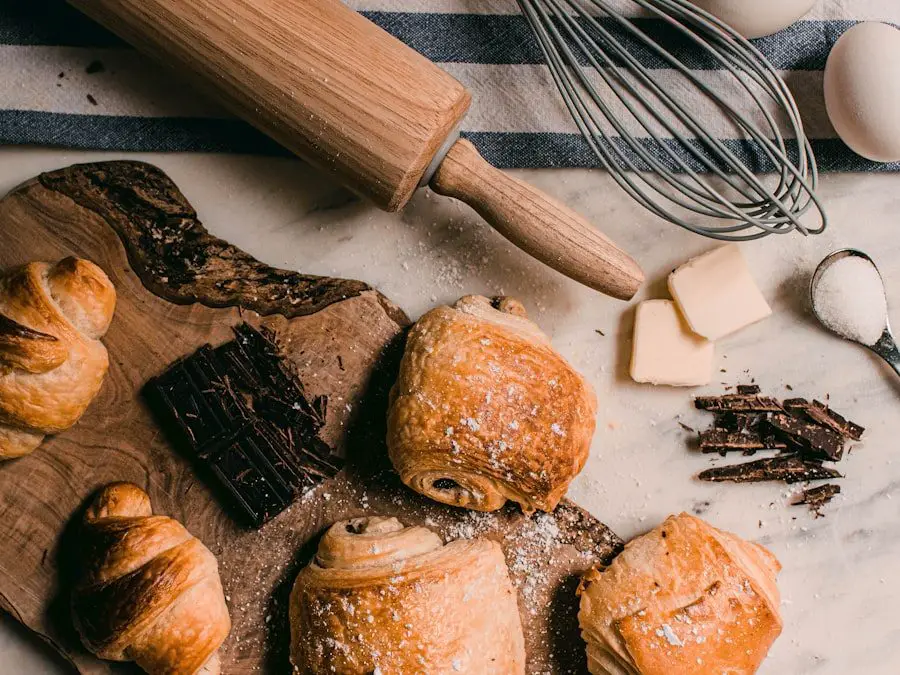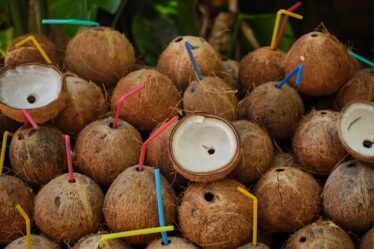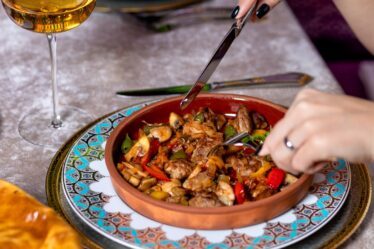
Pickling is a preservation method that has been used for centuries to extend the shelf life of fruits and vegetables. It is believed to have originated in ancient Mesopotamia, where people discovered that soaking food in a mixture of vinegar, salt, and spices could prevent spoilage. Over time, pickling techniques spread to different parts of the world, and today, there are countless varieties of pickles enjoyed by people all over the globe.
One popular type of pickle is the bread and butter cucumber pickle. These pickles are known for their sweet and tangy flavor, making them a favorite choice for many pickle enthusiasts. Bread and butter pickles are typically made with cucumbers, onions, vinegar, sugar, and a blend of spices such as mustard seeds, celery seeds, and turmeric. The result is a crunchy and flavorful pickle that can be enjoyed on its own or added to sandwiches, burgers, and salads.
Bread and butter pickles have gained popularity for several reasons. Firstly, their unique combination of sweet and tangy flavors appeals to a wide range of taste preferences. The sweetness comes from the sugar in the brine, while the tanginess comes from the vinegar. This balance of flavors makes bread and butter pickles a versatile condiment that can complement a variety of dishes.
Key Takeaways
- Bread and butter cucumber pickles are a popular type of pickles that are sweet and tangy.
- Making your own pickles can be a fun and rewarding experience, and allows you to control the ingredients and flavors.
- Choosing the right cucumbers for pickling is important, as they should be firm and have thin skin.
- Preparing the cucumbers for pickling involves washing, trimming, and slicing them to the desired thickness.
- The brine is a crucial component of pickling, as it helps to preserve the cucumbers and infuse them with flavor.
The Benefits of Making Your Own Pickles
Making your own pickles at home offers several benefits. Firstly, homemade pickles are often healthier than store-bought options. When you make your own pickles, you have control over the ingredients used, allowing you to avoid additives and preservatives commonly found in commercial pickles. Additionally, homemade pickles can be customized to suit your dietary needs and preferences. You can adjust the amount of sugar or salt used in the brine or experiment with different spices to create a flavor profile that suits your taste.
Another benefit of making your own pickles is cost-effectiveness. While store-bought pickles can be quite expensive, especially if you prefer organic or artisanal options, making your own pickles can save you money in the long run. Cucumbers are relatively inexpensive, and the other ingredients needed for pickling, such as vinegar and spices, are pantry staples that you likely already have on hand. By making your own pickles, you can enjoy the same delicious flavors at a fraction of the cost.
Lastly, making your own pickles can be a satisfying and rewarding experience. There is something special about creating something from scratch and seeing the transformation of cucumbers into delicious pickles. It allows you to connect with the food you eat and appreciate the time and effort that goes into the process. Additionally, making pickles at home gives you the opportunity to experiment with different flavors and techniques, allowing you to develop your own unique pickle recipes.
Choosing the Right Cucumbers for Pickling
When it comes to making pickles, choosing the right type of cucumber is crucial. Not all cucumbers are suitable for pickling, as some varieties have a higher water content and may become mushy during the pickling process. The best cucumbers for pickling are those that are firm and have a thin skin.
One important factor to consider when choosing cucumbers for pickling is their size. Smaller cucumbers, also known as pickling cucumbers or Kirby cucumbers, are ideal for pickling as they have a higher concentration of flavor and a firmer texture. These cucumbers are usually about 3-4 inches long and have bumpy skin. If you can’t find pickling cucumbers, English cucumbers can also be used for pickling. They are longer and smoother than pickling cucumbers but still have a firm texture.
When selecting cucumbers for pickling, it is important to choose ones that are fresh and free from blemishes. Look for cucumbers that are bright green in color and have a firm texture. Avoid cucumbers that are soft or have wrinkled skin, as these are signs of spoilage. If possible, buy cucumbers from a local farmer’s market or grow your own to ensure maximum freshness.
Preparing the Cucumbers for Pickling
| Step | Metric |
|---|---|
| Washing | Number of cucumbers washed |
| Trimming | Number of cucumbers trimmed |
| Slicing | Number of cucumbers sliced |
| Brining | Amount of salt used in brine |
| Seasoning | Amount of dill and garlic used for seasoning |
| Jarring | Number of jars filled with pickles |
Before you can start pickling cucumbers, it is important to properly wash and slice them. Start by rinsing the cucumbers under cold water to remove any dirt or debris. Use a vegetable brush to gently scrub the skin, paying extra attention to any areas with visible dirt. Once the cucumbers are clean, pat them dry with a clean kitchen towel.
Next, you will need to slice the cucumbers into your desired shape. Most bread and butter pickles are made with sliced cucumbers, but you can also choose to make spears or chips if you prefer. To slice the cucumbers, use a sharp knife or a mandoline slicer for even and consistent slices. Aim for slices that are about 1/4 inch thick.
After slicing the cucumbers, it is important to salt them before adding them to the brine. Salting the cucumbers helps draw out excess moisture, resulting in a crunchier pickle. To salt the cucumbers, place them in a colander and sprinkle them with kosher salt. Toss the cucumbers gently to ensure that they are evenly coated with salt. Let the cucumbers sit for about 1 hour, then rinse them thoroughly under cold water to remove any excess salt.
The Importance of Brine in Pickling
Brine is a crucial component of the pickling process as it provides flavor and helps preserve the cucumbers. Brine is a mixture of vinegar, water, sugar, salt, and spices. The vinegar acts as a natural preservative, while the sugar and salt help balance the flavors and add depth to the pickles. The spices in the brine contribute to the overall flavor profile of the pickles.
When making bread and butter pickles, it is important to achieve the perfect balance of sweet and sour in the brine. The sweetness comes from the sugar, while the tanginess comes from the vinegar. The ratio of sugar to vinegar can be adjusted to suit your taste preferences. If you prefer sweeter pickles, you can increase the amount of sugar in the brine. Conversely, if you prefer tangier pickles, you can increase the amount of vinegar.
To make the brine, combine vinegar, water, sugar, salt, and spices in a saucepan. Bring the mixture to a boil, stirring until the sugar and salt are fully dissolved. Once the brine is ready, let it cool slightly before pouring it over the cucumbers. It is important to use a non-reactive container, such as glass or stainless steel, when pouring hot brine over cucumbers to avoid any chemical reactions.
Selecting the Right Spices for Bread and Butter Pickles

Spices play a crucial role in creating the unique flavor profile of bread and butter pickles. Common spices used in bread and butter pickles include mustard seeds, celery seeds, turmeric, and cloves. These spices add depth and complexity to the pickles, enhancing their overall flavor.
When choosing spices for your bread and butter pickles, it is important to consider your taste preferences. Mustard seeds are a staple in bread and butter pickles as they add a subtle heat and nuttiness to the flavor profile. Celery seeds contribute a slightly bitter and earthy flavor, while turmeric adds a vibrant yellow color to the pickles. Cloves are often used sparingly as they have a strong and distinct flavor.
Experimenting with different spice combinations can be a fun way to personalize your pickles. You can try adding spices such as dill seeds, fennel seeds, or red pepper flakes to create unique flavor profiles. Keep in mind that some spices, such as red pepper flakes, can add heat to the pickles, so adjust the amount according to your spice tolerance.
Making Bread and Butter Pickles: Step-by-Step Guide
Now that you have selected the right cucumbers, prepared them for pickling, and created the brine, it’s time to make your bread and butter pickles. Here is a step-by-step guide to help you through the process:
1. Sterilize your jars: Before you start making the pickles, it is important to sterilize the jars to ensure maximum freshness and prevent spoilage. Wash the jars and lids in hot soapy water, then rinse them thoroughly. Place the jars and lids in a large pot filled with water and bring it to a boil. Let the jars and lids boil for about 10 minutes, then carefully remove them from the pot and let them air dry.
2. Pack the cucumbers into the jars: Take your sterilized jars and pack them tightly with the sliced cucumbers. Leave about 1/2 inch of headspace at the top of each jar to allow for expansion during the pickling process.
3. Pour the brine over the cucumbers: Once the jars are packed with cucumbers, carefully pour the cooled brine over them, making sure that all cucumbers are fully submerged. Use a clean spoon or spatula to remove any air bubbles trapped in the jars.
4. Seal the jars: Wipe the rims of the jars with a clean, damp cloth to remove any brine or residue. Place the lids on the jars and screw them on tightly. Make sure the lids are properly sealed to prevent any air from entering the jars.
5. Process the jars: There are two methods for processing the jars – water bath canning or refrigerator pickling. Water bath canning involves submerging the sealed jars in boiling water for a specific amount of time to create a vacuum seal. This method allows the pickles to be stored at room temperature for an extended period. Refrigerator pickling, on the other hand, involves storing the sealed jars in the refrigerator immediately after making them. This method does not require processing and allows the pickles to be enjoyed within a few days.
6. Let the pickles sit: Regardless of the method you choose, it is important to let the pickles sit for at least 24 hours before consuming them. This allows the flavors to develop and intensify.
Tips for Properly Storing Pickles
Properly storing pickles is essential to ensure maximum freshness and flavor. Here are some tips for storing your bread and butter pickles:
1. Choose the right containers: When storing pickles, it is important to use containers that are airtight and non-reactive. Glass jars with tight-fitting lids are ideal for storing pickles as they prevent air from entering and keep out any odors or flavors from other foods in your refrigerator.
2. Keep pickles refrigerated: Bread and butter pickles should be stored in the refrigerator to maintain their freshness and crunchiness. The cold temperature slows down the fermentation process, ensuring that the pickles stay crisp.
3. Use clean utensils: When serving pickles, always use clean utensils to avoid introducing bacteria into the jar. Dirty utensils can contaminate the brine and cause spoilage.
4. Store pickles away from sunlight: Exposure to sunlight can cause the pickles to spoil more quickly. Store the jars in a cool, dark place in your refrigerator to extend their shelf life.
5. Consume pickles within a few months: While properly stored pickles can last for several months, it is best to consume them within a few months for optimal flavor and texture. Over time, the pickles may become softer and lose some of their crunchiness.
Creative Ways to Use Bread and Butter Pickles
Bread and butter pickles are not just for sandwiches and burgers. They can be used in a variety of creative ways to add flavor and texture to your meals and snacks. Here are some ideas for incorporating bread and butter pickles into your culinary creations:
1. Add them to salads: Bread and butter pickles can add a tangy crunch to salads. Chop them up and toss them with mixed greens, cherry tomatoes, cucumbers, and your favorite dressing for a refreshing and flavorful salad.
2. Top off your tacos: Give your tacos a burst of flavor by adding bread and butter pickles as a topping. They pair well with grilled chicken, fish, or even vegetarian tacos.
3. Make pickle roll-ups: Spread cream cheese on slices of deli meat, then place a bread and butter pickle spear on top. Roll up the meat tightly and secure it with toothpicks for a quick and easy appetizer or snack.
4. Create a pickle-inspired sauce: Blend bread and butter pickles with mayonnaise, mustard, and a touch of honey to create a tangy sauce that can be used as a dip or spread for sandwiches.
5. Add them to deviled eggs: Finely chop bread and butter pickles and mix them into the filling for deviled eggs. The tanginess of the pickles adds a delicious twist to this classic appetizer.
6. Make pickle-flavored popcorn: Toss freshly popped popcorn with melted butter, dill pickle seasoning, and finely chopped bread and butter pickles for a unique and flavorful snack.
Enjoying the Fruits of Your Labor
Making your own bread and butter pickles can be a rewarding and enjoyable experience. From selecting the right cucumbers to preparing the brine and experimenting with different spice combinations, every step of the process allows you to connect with your food and create something delicious from scratch.
Once your pickles are ready, take the time to savor the fruits of your labor. Enjoy them on their own as a snack or incorporate them into your favorite dishes for an added burst of flavor. Share them with friends and family or give them as homemade gifts. The possibilities are endless when it comes to enjoying your homemade bread and butter pickles.
So why not give it a try? Pickling cucumbers is a fun and rewarding activity that allows you to create a delicious and versatile condiment that can be enjoyed year-round. Whether you’re a pickle enthusiast or just looking for a new culinary adventure, making bread and butter pickles at home is sure to be a satisfying experience. So roll up your sleeves, gather your ingredients, and get ready to embark on a pickling journey that will leave you with jars full of deliciousness.
If you’re a fan of pickles, you might also be interested in exploring the culinary potential of other fruits and vegetables. One article that caught my attention is “Unveiling the Delights of Plantains: From Sweet to Savory.” Plantains are a versatile ingredient that can be used in a variety of dishes, from sweet desserts to savory mains. If you’re looking to expand your culinary horizons, this article is definitely worth a read. Check it out here!



